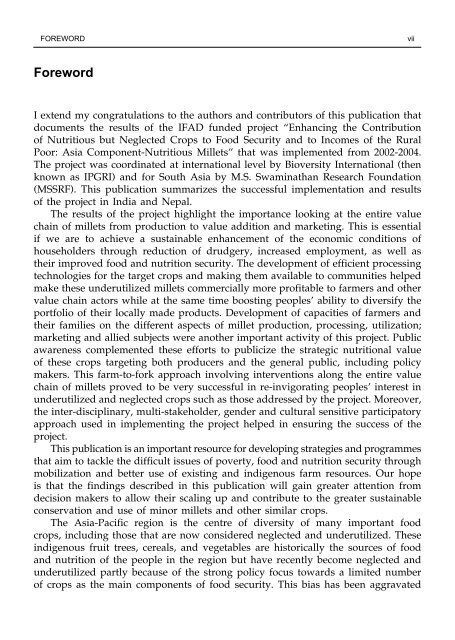Minor millets in South Asia: learnings from IFAD-NUS project in India ...
Minor millets in South Asia: learnings from IFAD-NUS project in India ...
Minor millets in South Asia: learnings from IFAD-NUS project in India ...
Create successful ePaper yourself
Turn your PDF publications into a flip-book with our unique Google optimized e-Paper software.
foreword vii<br />
Foreword<br />
I extend my congratulations to the authors and contributors of this publication that<br />
documents the results of the <strong>IFAD</strong> funded <strong>project</strong> “Enhanc<strong>in</strong>g the Contribution<br />
of Nutritious but Neglected Crops to Food Security and to Incomes of the Rural<br />
Poor: <strong>Asia</strong> Component-Nutritious Millets” that was implemented <strong>from</strong> 2002-2004.<br />
The <strong>project</strong> was coord<strong>in</strong>ated at <strong>in</strong>ternational level by Bioversity International (then<br />
known as IPGRI) and for <strong>South</strong> <strong>Asia</strong> by M.S. Swam<strong>in</strong>athan Research Foundation<br />
(MSSRF). This publication summarizes the successful implementation and results<br />
of the <strong>project</strong> <strong>in</strong> <strong>India</strong> and Nepal.<br />
The results of the <strong>project</strong> highlight the importance look<strong>in</strong>g at the entire value<br />
cha<strong>in</strong> of <strong>millets</strong> <strong>from</strong> production to value addition and market<strong>in</strong>g. This is essential<br />
if we are to achieve a susta<strong>in</strong>able enhancement of the economic conditions of<br />
householders through reduction of drudgery, <strong>in</strong>creased employment, as well as<br />
their improved food and nutrition security. The development of efficient process<strong>in</strong>g<br />
technologies for the target crops and mak<strong>in</strong>g them available to communities helped<br />
make these underutilized <strong>millets</strong> commercially more profitable to farmers and other<br />
value cha<strong>in</strong> actors while at the same time boost<strong>in</strong>g peoples’ ability to diversify the<br />
portfolio of their locally made products. Development of capacities of farmers and<br />
their families on the different aspects of millet production, process<strong>in</strong>g, utilization;<br />
market<strong>in</strong>g and allied subjects were another important activity of this <strong>project</strong>. Public<br />
awareness complemented these efforts to publicize the strategic nutritional value<br />
of these crops target<strong>in</strong>g both producers and the general public, <strong>in</strong>clud<strong>in</strong>g policy<br />
makers. This farm-to-fork approach <strong>in</strong>volv<strong>in</strong>g <strong>in</strong>terventions along the entire value<br />
cha<strong>in</strong> of <strong>millets</strong> proved to be very successful <strong>in</strong> re-<strong>in</strong>vigorat<strong>in</strong>g peoples’ <strong>in</strong>terest <strong>in</strong><br />
underutilized and neglected crops such as those addressed by the <strong>project</strong>. Moreover,<br />
the <strong>in</strong>ter-discipl<strong>in</strong>ary, multi-stakeholder, gender and cultural sensitive participatory<br />
approach used <strong>in</strong> implement<strong>in</strong>g the <strong>project</strong> helped <strong>in</strong> ensur<strong>in</strong>g the success of the<br />
<strong>project</strong>.<br />
This publication is an important resource for develop<strong>in</strong>g strategies and programmes<br />
that aim to tackle the difficult issues of poverty, food and nutrition security through<br />
mobilization and better use of exist<strong>in</strong>g and <strong>in</strong>digenous farm resources. Our hope<br />
is that the f<strong>in</strong>d<strong>in</strong>gs described <strong>in</strong> this publication will ga<strong>in</strong> greater attention <strong>from</strong><br />
decision makers to allow their scal<strong>in</strong>g up and contribute to the greater susta<strong>in</strong>able<br />
conservation and use of m<strong>in</strong>or <strong>millets</strong> and other similar crops.<br />
The <strong>Asia</strong>-Pacific region is the centre of diversity of many important food<br />
crops, <strong>in</strong>clud<strong>in</strong>g those that are now considered neglected and underutilized. These<br />
<strong>in</strong>digenous fruit trees, cereals, and vegetables are historically the sources of food<br />
and nutrition of the people <strong>in</strong> the region but have recently become neglected and<br />
underutilized partly because of the strong policy focus towards a limited number<br />
of crops as the ma<strong>in</strong> components of food security. This bias has been aggravated

















